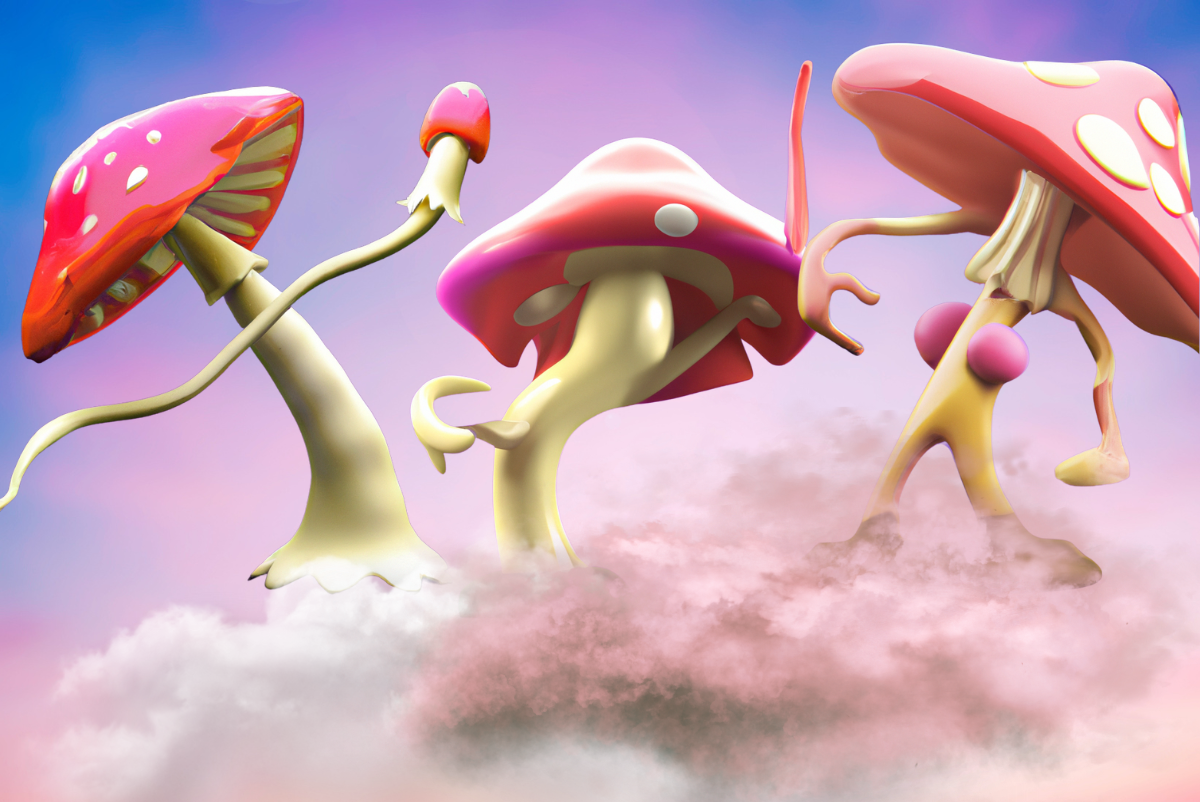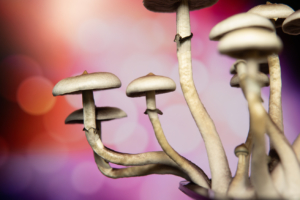
We recently published an article about the (tentatively) legal shroom that’s blowing up the internet —the Amanita muscaria. But our last piece only touched on the logistics of consuming it, with only a brief nod to its rich history. This piece will take the reader back in time, through a historical journey alongside the Amanita muscaria and all of the roles it has played in the past, and all the cultures that it’s touched while doing so.
Siberian Religions
The Amanita muscaria was frequently used in pre-Christian religious traditions of the indigenous people of Siberia. Its use as an entheogen was known and spread across the Russian Far East and Western Siberia, though use varied across the continent. In the west, its use was restricted only to practicing shamans or shaman-like figures. The psychoactive component of the Amanita muscaria allowed them to achieve trance-like states that could previously only be found through dance and drumming. Conversely, in eastern Siberia, use of the Amanita muscaria effect was for everyone and for not just religious rites —it was also used recreationally. However, only the shaman could eat the mushroom on its own —laypeople would have to drink the urine of the shaman after consumption. Sound a little kinky? It may have been, but really what happened was that the first eater, or the shaman, essentially acted as a filter for everyone else —their urine still contained the psychoactive elements of the Amanita muscaria, while also eliminating some of the negative side effects that came along with eating it, such as twitching or stomach pains. In fact, it’s possible that the psychoactive pee was actually more potent than the mushroom itself, so maybe it wasn’t all bad to be on the receiving end.
Koryaks
The Koryaks are a group of indigenous people from eastern Siberia, from the Kamchatka Peninsula just off the coast of the Bering Sea. They still inhabit the area today, and are culturally and linguistically very similar to the Chuchkis, another Siberian indigenous group from the extreme northeast.
According to Koryak folklore, the Amanita muscaria mushroom was a “sacred gift” from Big Raven, who was the first shaman and the causal beginning of the human race. Supposedly, big raven discovered the power of the mushroom when he had caught a whale, but wanted to put him back into the sea. The whale was too big and heavy for Big Raven, and he wanted help from Vahiyinin, or Existence. Vahiyinin created the Amanita muscaria, which it called wapaq, by spitting on the land, its white spots representing the spit. Big Raven ate the resulting mushroom and with it came the strength to throw the whale back into the sea.
When he had eaten wapaq, Big Raven became exceedingly strong, and he pleaded, ‘O wapaq, grow forever on the earth’” as recounted by Richard Evans Shultes and Albert Hofmann in Plants of the Gods. He then told his people that the Amanita muscaria, or wapaq, could help and teach them, and so it stayed as a majorly relevant part of their folklore for centuries, until alcohol was introduced to the culture in the 16th and 17th century by the Russians. In an interesting flip, while mushrooms are very important to Russian culture (even I remember hunting for mushrooms as a child with my grandparents in the dense forests of the country), red-capped shrooms are typically strongly advised against —if they’re bright, it’s better to be left alone. The Koryaks, however, took a special interest in the Amanita muscaria, and often made it a central pillar of their folklore, rituals, and even day-to-day life. Reindeer that ate the mushroom often exhibited signs of intoxication, after which hunters would chase it down to eat its meat, hoping to get some of the residual effects.
Celtic Druids
The Celtic Druids are thought to have used the Amanita muscaria in pre-Christian religious traditions and rituals. Under the awareness that it was supposed to be toxic, the druids would first prepare the Amanita muscaria for consumption, and then eat it specifically for the hallucinations it could give. They believed the mushroom and its organism to be ancient, and that through eating it and experiencing its visions and hallucinations, one could inherit some of its ancient wisdom and be put into direct communication with the universe.
Furthermore, the Amanita muscaria was thought to give one visions of faeries and leprechauns —both very spiritual creatures deeply associated with Ireland and its historic folklore. To this day, Irish slang calls a magic mushroom trip a time where one “goes away with the faeries” or “off with the pixies.”
Aryans of India
The ancient Aryan people of modern-day India had a drug called Soma, and it was suggested by R. Gordon Wasson that Soma might be the Amanita muscaria mushroom. Wasson was the man who helped introduce magic mushrooms to the western world with the help of Oaxacan curandera (medicine woman) Maria Sabina in the 1950s.
The Aryans were around about 3,500 years ago, and they, like many ancient civilizations, had a polytheistic religion. One of their gods, known as Soma, was particularly unique, being not only a god, but also a plant —apparently the only plant to have been “deified in human history.”
The Aryans left little in terms of historical artifacts, save for over 1,000 hymns, which were passed on through generations by oral traditions and memory alone. Eventually, Western explorers wrote down the hymns, and while the meaning of them remains somewhat obscure. According to the Vedas, Soma was taken by priests during liturgical worship. First, it was mixed with water, then beaten with stones (poor thing). Then it was mixed with more water, honey, or barley, and drunk by the priests, who would enter inebriated states.
Why did Wasson believe Soma was actually the Amanita muscaria mushroom? Wasson’s essay offers an explanation: The hymns of the Aryans, composed over centuries, never mention roots, leaves, blossoms, or seeds of the Soma. What plant has none of these? “The whole of the fungal world.” Furthermore, the hymns often mention that the Soma is found on mountains —where the Amanita muscaria grows. These, among other descriptions and turns of language allow the educated guess that the Soma, often referred to as “Fireplant” and “Sun-plant,” is actually the Amanita muscaria we all know and love.
Greeks
Soma wasn’t just found in ancient Aryan traditions, the ancient Greeks found it too. Dionysus, the ancient Greek god of fertility and mysticism, among other things, threw an annual October festival called the Ambrosia, meaning, literally, “immortality,” and taken from the ancient Greek food of the same name, labelled the “food of the gods.”
The Dionysian cult was known to consume Soma for “ecstatic” purposes, enjoying its inebriating effects and sleepy pleasures, before eventually, like the Siberian indigenous folk in later years, discovering alcohol and switching to it for intoxication purposes. If Wasson’s previous identification of the Aryan plant-god Soma is correct, we can also assume that the Soma was the same for the Greeks —Amanita muscaria.
October is generally known as mushroom season. The six ingredients that make up ambrosia were written down in such a way that their first initials spelled “myketa,” which is the Greek word for mushroom. This, along with several other layers of meaning, allow some to conclude that the ancient Greek’s ambrosia drink was made with none other than the Amanita muscaria.
Vikings
It’s rumored that vicious Viking warriors known as “berserkers” would eat the Amanita muscaria before battle, allowing its effects to take them into a trancelike fighting rage. The “extra strength” story lines up with the Koryak folktale of Big Raven. If this is true, perhaps the pre-workout industry has found a new, natural ingredient. That said, little is known about the Vikings and berserkers, though one paper even suggests that henbane, a plant often used in “magic brews” and as medicine, could have been the actual pre-battle snack of choice for these fighters.
Santa Claus
We know Santa is red and white and jolly, but why? Somewhat randomly, the Amanita muscaria could have a lot to do with our idea of Santa Claus today.
A dive into Santa’s history shows us that our current concept of the star of Christmas comes from a mosaic of European influences and folk characters, the most famous of which is jolly old Saint Nick, a wealthy archbishop born in the third century who took Jesus’ words of giving to the poor to heart, and spent his inheritance after his parents died helping the poor and needy. He was renowned for his kindness and generosity, and became a pillar of Christian faith. Santa as we know him is based on this man.
So what does a supposedly magic mushroom have to do with the man who knows when you’ve been bad or good? Apparently, quite a lot. Siberian culture involved the use of Amanita muscaria quite a bit, especially around festivals and rituals. During their annual midwinter festival, the shaman of the region would enter celebratory yurts through the smoke hole (self-explanatory —it’s where the smoke comes out) and bring a bag of the mushroom with him which would be distributed as gifts. The shaman would then perform the cultural ceremonies of the time and leave through the smoke hole again. Prior to this, when gathering the mushroom, the shaman would often wear a red and white outfit —the colors of the Amanita muscaria.
Villagers would think that the shaman could fly, or would fly with the help of reindeer (which we already know would often eat the Amanita muscaria themselves). The similarity is a bit uncanny. Today’s Santa Claus is dressed in the same bright red and white costume as the Amanita muscaria, lives in the North, carries a bag of presents, flies on a sled and magic reindeer, and enters homes through chimneys (though what he does when faced with apartment buildings remains unknown).
Stories And Fairy Tales
The Amanita muscaria, with its bright, beautiful appearance and unusual mind-altering properties has been a staple of folklore and storytelling for thousands of years. We see it in ancient oral traditions and in modern tales, too. Victorian era paintings of fairies prominently display the Amanita muscaria. When in Wonderland, Alice can eat a mushroom that makes her change in size —though we never get much physical description of it, it’s possible it was inspired by the Amanita muscaria. When Mario eats the red mushroom he turns into his Super form. The Smurfs live in a red mushroom, and countless other references have been made to it in art and literature new and old.
The Amanita muscaria is the most iconic and well-known mushroom in the world. Its image is plastered across paintings, video games, and fairy tales. It’s been used as decoration, as inspiration, as an inebriant, and more. Its shining red cap with white spots is one of the most recognizable images in the world. Despite being given a bad rap as something distinctly poisonous and toxic, the truth is that the Amanita muscaria is an enigma, one whose likeness and psychoactive properties have transcended generations and cultures. The Amanita muscaria is more than just a mushroom, it’s a part of a rich and fascinating story of humanity and how we interact with the plants, fungi, and drugs around us.





